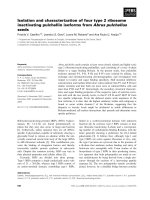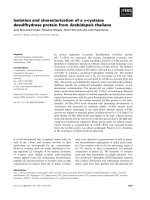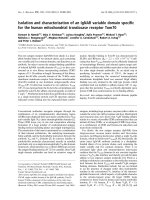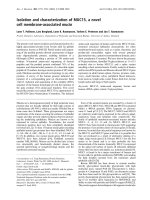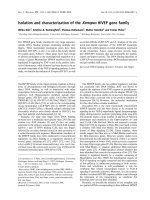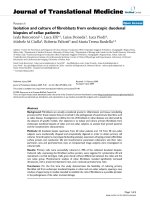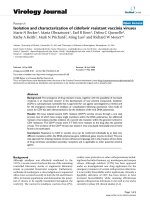Báo cáo hóa học: " Isolation and characterization of cidofovir resistant vaccinia viruses" pot
Bạn đang xem bản rút gọn của tài liệu. Xem và tải ngay bản đầy đủ của tài liệu tại đây (624.17 KB, 8 trang )
BioMed Central
Page 1 of 8
(page number not for citation purposes)
Virology Journal
Open Access
Research
Isolation and characterization of cidofovir resistant vaccinia viruses
Marie N Becker
1
, Maria Obraztsova
1
, Earl R Kern
2
, Debra C Quenelle
2
,
Kathy A Keith
2
, Mark N Prichard
2
, Ming Luo
2
and Richard W Moyer*
1
Address:
1
University of Florida, Gainesville, FL, USA and
2
University of Alabama at Birmingham, Birmingham, AL, USA
Email: Marie N Becker - ; Maria Obraztsova - ; Earl R Kern - ;
Debra C Quenelle - ; Kathy A Keith - ; Mark N Prichard - ;
Ming Luo - ; Richard W Moyer* -
* Corresponding author
Abstract
Background: The emergence of drug resistant viruses, together with the possibility of increased
virulence, is an important concern in the development of new antiviral compounds. Cidofovir
(CDV) is a phosphonate nucleotide that is approved for use against cytomegalovirus retinitis and
for the emergency treatment of smallpox or complications following vaccination. One mode of
action for CDV has been demonstrated to be the inhibition of the viral DNA polymerase.
Results: We have isolated several CDV resistant (CDV
R
) vaccinia viruses through a one step
process, two of which have unique single mutations within the DNA polymerase. An additional
resistant virus isolate provides evidence of a second site mutation within the genome involved in
CDV resistance. The CDV
R
viruses were 3–7 fold more resistant to the drug than the parental
viruses. The virulence of the CDV
R
viruses was tested in mice inoculated intranasally and all were
found to be attenuated.
Conclusion: Resistance to CDV in vaccinia virus can be conferred individually by at least two
different mutations within the DNA polymerase gene. Additional genes may be involved. This one
step approach for isolating resistant viruses without serial passage and in the presence of low doses
of drug minimizes unintended secondary mutations and is applicable to other potential antiviral
agents.
Background
Although smallpox was effectively eradicated in the
1970's, a recent concern has been the use of the remaining
controlled laboratory stocks or engineered laboratory
strains as potential bioterrorist weapons. Furthermore,
outbreaks of monkeypox, a virus indigenous to equatorial
Africa, have occurred recently in both the US and Western
Africa in human populations and demonstrate the poten-
tial of viruses to be rapidly transmitted throughout the
world [1]. The vaccine for smallpox, vaccinia virus (VV),
confers cross protection to other orthopoxviruses includ-
ing those that infect humans, e.g. monkeypox and cowpox
viruses. Although cidofovir (CDV) has been approved
under an investigational new drug application for the
emergency treatment of certain orthopoxvirus infections,
it is not orally bioavailable and is nephrotoxic. Recently a
lipophilic derivative of CDV has been shown to have
increased bioavailability while retaining effectiveness
against orthopoxvirus infections in vitro and in vivo and is
currently in phase I/II clinical studies [2-4].
Published: 14 May 2008
Virology Journal 2008, 5:58 doi:10.1186/1743-422X-5-58
Received: 18 April 2008
Accepted: 14 May 2008
This article is available from: />© 2008 Becker et al; licensee BioMed Central Ltd.
This is an Open Access article distributed under the terms of the Creative Commons Attribution License ( />),
which permits unrestricted use, distribution, and reproduction in any medium, provided the original work is properly cited.
Virology Journal 2008, 5:58 />Page 2 of 8
(page number not for citation purposes)
CDV is a nucleotide analog and thus the proposed target
of its interaction is the viral DNA polymerase. CDV resist-
ant (CDV
R
) orthopoxviruses were isolated previously via
serial passage [5,6]. Subsequently, in the case of CDV
R
VV
the mutations responsible for resistance were mapped to
the viral DNA polymerase [5,7]. The virus described by
Andrei et al. contains two mutations within the DNA
polymerase and those isolated by Smee et al. contain 5
mutations [5,7,8]. Our goal was to identify additional
mutations and through a process that would promote the
isolation of resistant viruses containing single mutations
and to map those mutations to help provide insight about
the interaction of the drug with the enzyme.
Results
CDV cytotoxicity, effective concentration for abolishing VV
plaque formation
We first established the concentration of CDV that would
effectively eliminate wt VV plaques without having signif-
icant cytotoxic effects on the BSC40 cells (Figure 1). The
concentrations that were utilized were based on previous
work [9] which indicated that the EC
50
for CDV is ~50 μM.
Concentrations as low at 50 μM were effective in eliminat-
ing plaque formation. We chose to use 150 μM, a value
three times the EC
50
as the concentration for selection of
mutants and no cytotoxicity was apparent at this concen-
tration in these cells. Two different virus strains, VV WR
and VV TK::GFP were initially used to isolate resistant
mutants. The presence of GFP made the identification of
small plaques much easier; however, this parental virus is
thymidine kinase (TK) negative thus attenuating the virus
and rendering it an unsuitable backbone to later assess the
CDV
R
virus phenotype in animals [10]. Indeed, since TK
indirectly impacts DNA synthesis, a second goal of these
studies was to determine whether the inhibitory concen-
trations of CDV and subsequent mutant selection were
impacted by deletion of this enzyme. This was deemed to
not be the case as mutants were readily isolated from
either virus at comparable concentrations of CDV and is
consistent with results published previously [11]. To
insure selection of independent mutations, 10 individual
plaque purified stocks from both VV WR and VV TK::GFP,
were used as the parental lines for the isolation of resistant
mutants. A total of six independent resistant viruses were
isolated and the DNA polymerase, E9L, gene was
sequenced from each virus (Table 1). Each of these viruses
contained a mutation(s) in the viral DNA polymerase.
Marker rescue and mapping of mutations conferring
resistance
In order to confirm that the mutation detected in the E9L
gene was responsible for the CDV resistance, we per-
formed a series of marker rescue experiments and the
results of the marker rescue experiments for isolates CDV
R
1 and 2 are shown in Figure 2. DNA fragments from drug
resistant isolates were amplified by PCR and used to trans-
fect wild type VV infected cells (Fig. 2A). Resulting viruses
were plaqued in the presence of CDV to score for marker
rescue (Fig. 2B). Only PCR products that contained a
mutation conferring resistance to CDV should produce
plaques, in this example, PCR fragments E9 and 14 (Fig.
2B). To remove the possibility of second site mutations in
the original virus, resistant viruses were reconstructed in a
wild type VV background by transfecting PCR products
containing only a single mutation in E9L. For CDV
R
1 and
Mapping and marker rescue of recombinant virusesFigure 2
Mapping and marker rescue of recombinant viruses.
A. Map of PCR fragments in the E9L region that were used
for marker rescue mapping experiments and reconstruction
of resistant viruses. B. Results of mapping experiment for
CDV
R
1 and 2. Monolayers of BSC 40 cells infected with virus
resulting from infection/transfections of VV WR and the indi-
cated PCR fragments and stained with crystal violet. CDV
was present at 150 μM. Only those PCR fragments that con-
tain the mutation conferring resistance to CDV are capable
of producing recombinant viruses that were detectable in the
plaque assay.
E9L E11
PCR 13
PCR 14
PCR 15
E9
A
CDV
R
1
CDV
R
2
PCR 14PCR 13 PCR 15E9
B
VV sensitivity to CDVFigure 1
VV sensitivity to CDV. Drug concentrations of as low as
50 μM are effective at abolishing plaque formation.
Virology Journal 2008, 5:58 />Page 3 of 8
(page number not for citation purposes)
2 we used PCR fragment 14 containing the A314V muta-
tion. For CDV
R
15 a fragment containing the M671I muta-
tion was used and for CDV
R
16, a fragment with the ΔK174
mutation was transfected. The reconstructed viruses are
designated with an "A" following the original virus name
to distinguish them from the original isolates. Recon-
structed viruses containing only the identified mutation
in E9L in a wild type VV background were sufficient to
confer CDV resistance except for CDV
R
15. We were una-
ble to reconstruct the CDV
R
15A virus (Table 1) cleanly
despite several attempts and the resulting reconstructed
virus always contained two mutations within the E9L
gene, the original mutation (M671I) and a second muta-
tion that corresponds to the same mutation found in
CDV
R
16 (ΔK174). This was observed multiple times and
indicates quite clearly, that the resistance that allowed the
isolation of CDV
R
15 containing the M671I mutation
depends on a second contributing mutation in the origi-
nal CDV
R
15 isolate outside of the DNA polymerase for
resistance. Furthermore, this second site mutation in
CDV
R
15, outside the DNA polymerase can be compen-
sated for by a specific second mutation in the DNA
polymerase, ΔK174. In contrast, CDV
R
16A was success-
fully reconstructed to contain only the original ΔK174
mutation.
Growth properties of CDV
R
viruses
Each of the three reconstructed viruses, CDV
R
1A, 15A and
16A were analyzed for their growth properties compared
to wt VV. The growth curves in Figure 3 indicate that all
three CDV resistant strains grew less well than wild type
virus although CDV
R
16A did produce titers reaching wild
type levels after an initial lag in growth. All three resistant
strains produced very small plaques compared to wild
type virus, with CDV
R
1A producing "pinpoint" plaques
after three days. CDV
R
1A and 15A ultimately produced
much less total virus than wild type or CDV
R
16A.
Levels of resistance
We confirmed that the viruses were resistant to CDV in
two additional cell lines at another laboratory (Table 2).
The EC
50
for CDV was obtained in HFF and Vero cells and
compared to two independently obtained strains of
parental VV WR. The resistant viruses had EC
50
values that
were 3 to 7 fold higher than the parental virus strains. The
greatest resistance was with CDV
R
1A containing the muta-
tion at A314V which produced the smallest plaques and
lowest titers.
Virulence of CDV
R
viruses in mice
It has been previously reported that CDV
R
VV is attenuated
in mice. We assessed the virulence of our reconstructed
viruses in mice inoculated intranasally (Tables 3 and 4)
and confirmed that all of our resistant strains were signif-
icantly attenuated in this model. No mice were killed by
the CDV
R
15A strain even at the highest dose given, so an
LD
90
could not be established.
Modeling of E9 and location of mutations
No crystal structures of VV E9 exist in the protein data-
base. However, E9 exhibits significant homology to the
type B family of DNA polymerases. Residues 429–809 of
E9 could be aligned with residues 279–597 of Thermosta-
ble B Type DNA Polymerase from Thermococcus gorgonariu
Table 2: Activity of CDV Against Wild Type and CDV Resistant VV using a Plaque Reduction Assay in Human Foreskin Fibroblast and
Vero Cells
Virus HFF EC
50
(μM)
a
Vero EC
50
(μM)
a
Fold resistance over parental strain (HFF) Fold resistance over parental strain (Vero)
VV-WR, UAB 28 ± 4.4 62 ± 12 - -
VV-WR, Moyer 18 ± 9.2 54 ± 2.9 - -
CDV
R
1A 122 ± 69 >317 ± 0 7 >6
CDV
R
15A 98 ± 55 214 ± 17 5 4
CDV
R
16A 49 ± 4.5 199 ± 2.8 3 4
a
Values are the mean ± standard deviation of two or more assays.
Table 1: CDV resistant VV E9L genotype
Virus Parental virus strain Original mutation in E9L E9L sequence of reconstructed virus
CDV
R
1 VV WR A314V A314V
CDV
R
2 VV TK::GFP A314V A314V
CDV
R
11 VV TK::GFP, line 11 A314V; P738S ND
CDV
R
14 VV WR, line 14 A314V ND
CDV
R
15 VV WR, line 15 M671I M671I, ΔK174
CDV
R
16 VV WR, line 16 ΔK174 ΔK174
Virology Journal 2008, 5:58 />Page 4 of 8
(page number not for citation purposes)
with 41% homology (E value = 1e-15). This region repre-
sents the catalytic core of the DNA polymerase. By mode-
ling E9 on the crystal structure of Thermococcus gorgonariu
DNA polymerase (PDB code 1TGO) it appears that the
location of the M671I mutation is not far from the active
site in the putative polymerase domain (Figure 4). A sum-
mary of known mutations conferring drug resistance is
presented in Figure 5. A number of mutations cluster in
the exonuclease domain, including those at residue 314 as
previously noted [5].
Discussion
Although mutations in DNA polymerase that confer
resistance to CDV have been previously isolated, this is
the first report of a selection procedure that is sufficient to
isolate single mutations conferring resistance. In this
study we report that the A314V mutation alone confers
significant resistance to CDV. This mutation was isolated
several times independently. Previous studies by Andrei et
al. (2006) had demonstrated that a mutation of alanine
314 to threonine conferred resistance to CDV; however,
higher levels of resistance were obtained when this muta-
tion was in combination with a second mutation, A684V,
found in the original isolate [5]. This study used drug con-
centrations twice as high as our study for the characteriza-
tion of these viruses. Our lower drug concentrations
indicate that even at low doses of drug the development
of resistant viral strains can pose a problem.
Two other mutations conferring resistance were also iso-
lated. One is a novel mutation of the deletion of amino
acid K174 within the putative exonuclease domain of the
DNA polymerase. Again, this mutation alone conferred
resistance; however, the level of resistance is not as great
as that for A314V. Examination of the CDV
R
15 mutant
provided some of the most interesting results. In our orig-
inal isolation of CDV
R
15 we found only a single mutation
within the E9 gene, however, upon reconstruction this
mutation alone cannot confer resistance and attempts to
reconstruct this virus resistant to CDV always contained
the ΔK174 mutation as well. This implied that the original
CDV
R
15 virus we isolated must contain a second muta-
tion elsewhere in the genome other than in the DNA
polymerase. Further analysis of CDV
R
15 by marker rescue
experiments should allow identification of this second
target gene. The lower titers of the CDV
R
stocks that were
produced severely limited the amount of virus that could
be used in this model. However, as expected from previ-
ous work, all three of our reconstructed virus strains grew
somewhat less well than wild type virus and were attenu-
ated in the mice by more than one log [5].
Model of the catalytic core of E9 polymeraseFigure 4
Model of the catalytic core of E9 polymerase. The
green ribbons correspond to the homologous region as
modeled. Met671 is shown as a red stick model and the
active site residues Asp, Thr, Asp, Ser are shown as blue
stick models. The yellow ribbons are included to show the
remaining part of the catalytic domains of the 1TGO
polymerase, but there is no significant amino acid sequence
homology between the two polymerases. The figure was
prepared with PyMol.
Growth properties of CDV
R
virusesFigure 3
Growth properties of CDV
R
viruses. BSC40 cells were
infected with either VV WR; CDV
R
1A; CDV
R
15A or CDV
R
16A at an MOI = 0.02. Samples were harvested at 1, 3, 6, 9,
12, 24, 48, and 72hpi. Samples were titered on CV1 cells and
the results graphed.
010203040
50 60 70 80
1
2
3
4
5
6
7
8
9
Hours post infection
pfu/ml, log
10
VV
1A
15A
16A
Virology Journal 2008, 5:58 />Page 5 of 8
(page number not for citation purposes)
Conclusion
The results obtained from these studies provides further
evidence that the primary but not sole target of CDV is the
viral DNA polymerase and that drug resistance can be a
significant problem even in the presence of relatively low
doses of drug. It is important to note that these drug resist-
ant mutants all had reduced virulence in mice and suggest
that the development of these mutants may not contrib-
ute to enhanced disease.
Methods
Cells and viruses
Monolayer cultures of BSC40 cells (Dr. Richard Condit)
were maintained in Dulbecco's modified Eagle medium
(DMEM) supplemented with 10% fetal bovine serum
(FBS) (Gibco), 50 IU of penicillin, and 50 μg of strepto-
mycin per ml (Cellgro, Herndon, Va.) [12]. CV1 cells
(ATCC, CCL-70) were maintained in minimal essential
media (MEM) with Earle's salts supplemented with 5%
FBS, 340 mM sodium pyruvate, 50 U/ml penicillin, 50 μg/
ml streptomycin and non-essential amino acids. Vero
Cells were obtained from ATCC and were maintained in
MEM with Earl's salts and the addition of 10% FBS and
standard concentrations of L-glutamine, penicillin and
gentamicin. Methods for obtaining and passaging human
foreskin fibroblast (HFF) cells were described previously
[13]. All cell lines were maintained at 37°C in the pres-
ence of 5% CO
2
.
The parental viruses used for isolation of CDV
R
mutants
were VV WR and VV TK::GFP. VV TK::GFP contains the
GFP gene driven by the synthetic VV early-late promoter
inserted into the thymidine kinase (tk) gene. This virus was
generated via standard methods using a pSC65GFP clone
in order to recombine the GFP gene into the TK locus of
wild type VV [14]. Virus titers were determined by stand-
ard plaque assays. To obtain CDV
R
mutants, 20 independ-
ent virus stocks were generated from single plaques from
the original VV TK::GFP (lines 1–10) and VV WR (lines
11–20) virus stocks.
Cidofovir
CDV was provided by Gilead Sciences, Foster City, CA.
Stock solutions of CDV (5 mM) in DMEM without serum
was stored at 4°C and protected from light.
Isolating independent CDV
R
mutant viruses
Confluent monolayers of BSC40 cells in 6-well plates
were infected with 2 × 10
4
PFU/well of either VV WR or VV
TK::GFP in DMEM with no supplements except for 150
μM CDV. After 60 min of adsorption an additional 1.5 ml
of DMEM with 10% FBS, antibiotics and 150 μM CDV
was added to each well. Plates were incubated at 37°C for
48 h and examined for plaques under the light micro-
scope, or with fluorescence for GFP containing plaques.
To isolate identified plaques, the liquid medium was care-
fully removed and the plaque was scraped with a 1 ml
Table 4: Mortality of BALB/c Mice Inoculated Intranasally with
Wild Type or CDV Resistant Vaccinia Viruses
Mortality
Virus
a
Number Percent MDD
b
LD
90
VV-WR
c
1.6 × 10
4
15/15 100 8.5 4.4 × 10
3
1.6 × 10
3
2/15 13 8.5
1.6 × 10
2
0/15 0
16 0/15 0
1.6 0/15 0
CDV
R
15A
c
Stock, 6 × 10
4
0/15 0
6 × 10
3
0/15 0
6 × 10
2
0/15 0
60 0/15 0
6 0/15 0
CDV
R
16A
c
Stock, 8 × 10
5
3/15 20 8.0 >8 × 10
5
8 × 10
3
0/15 0
8 × 10
2
0/15 0
80 0/15 0
8 0/15 0
a. Virus was delivered i.n. in 0.04 (0.02 ml/nostril) ml doses.
b. MDD = Mean Day of Death.
c. Inoculum, PFU/mouse.
Table 3: Mortality of BALB/c Mice Inoculated Intranasally with
Wild Type or CDV Resistant Vaccinia Viruses
Mortality
Virus
a
Number Percent MDD
b
LD
90
VV-WR, UAB
c
2.8 × 10
4
10/10 100 7.1 2.9 × 10
3
2.8 × 10
3
7/10 70 8.1
2.8 × 10
2
2/10 20 9.0
28 0/10 0
2.8 0/10 0
VV-WR, Moyer
c
1.3 × 10
4
10/10 100 7.8 <1.3 × 10
4
1.3 × 10
3
0/10 0
1.3 × 10
2
0/10 0
13 0/10 0
1.3 0/10 0
CDV
R
1A
c
Stock 1.2 × 10
4
0/10 0 >1.2 × 10
4
1.2 × 10
3
0/10 0
1.2 × 10
2
0/10 0
12 0/10 0
1.2 0/10 0
a. Virus was delivered i.n. in 0.04 (0.02 ml/nostril) ml doses.
b. MDD = Mean Day of Death.
c. Inoculum, PFU/mouse.
Virology Journal 2008, 5:58 />Page 6 of 8
(page number not for citation purposes)
large bore pipette tip and transferred into 1 ml of DMEM
without serum and stored at -80°C. Routinely, 2 plaques
from each individual virus stock were isolated. The virus
from the original plaque was plaque purified one addi-
tional time under agarose and in the presence of 150 μM
CDV to ensure that it was a single isolate. From these
dishes, plaques were picked and subsequently amplified.
Sequencing Analysis
DNA sequences of the DNA polymerase (E9L) gene from
the viruses were obtained by direct sequencing of the PCR
products amplified from the total DNA of infected cells.
The DNA was prepared from virus infected cells with the
DNeasy Tissue Kit (Qiagen Inc., Valencia,, CA), according
to the manufacturer's protocol. The entire E9L gene was
PCR amplified using two primers IDT327, 5'-ATGGATGT-
TCGGTGCATTAATTGGT-3' and IDT328, 5'-TTATGCT-
TCGTAAAATGTAGGTTTTGAACC-3' and then sequenced
with primers that hybridize within E9L to give overlap-
ping sequence data. Sequencing was performed by the
University of Florida ICBR DNA Sequencing Core Labora-
tory.
Reconstruction of CDV
R
mutants by marker rescue
Mapping of the individual mutations conferring resist-
ance and the reconstruction of the mutation(s) in a wild
type VV background were performed as described previ-
ously [15]. Confluent monolayers of BSC40 cells in 6 well
dishes were infected with 5 × 10
3
PFU of wt VV WR in a
volume of 0.5 ml and 30 min later transfected with 1.5 –
2 μg DNA complexed with 12 μl Lipofectamine 2000 per
manufacturer's instructions (Invitrogen). Different PCR
products from the mutant CDV
R
viruses were used for
transfection including products containing the entire E9L
gene or products containing only portions of E9L gene. A
map of the fragments used is found in Figure 2. PCR frag-
ment 13 is approximately 5 kb and contains approxi-
mately half of E9L at the 3' end as well as DNA
downstream of E9L into E6 (primers 5'-TACGATGTTG-
TAAAGTGTACGAAGCG-3'; 5'-AGTTAGAGAAATGACGT-
TCATCGGTG-3'). The 5' portion of E9L is contained in a
5 kb fragment, #14, generated with 5'-TTTGTTTTGGAG-
CAAATACCTTACCG-3' and 5'-CGAGAGTGGTTGAAT-
GTTTGACTGTG-3'. As a negative control, fragment 15
approximately 2.9 kb upstream of E9L translational start
site was used in transfections (5'-AAATAGTCACGCAAT-
TCATTTTCGGG-3'; 5'-TGCTTTTGATGGTAATTTCTGGT-
GCC-3'). All primers and fragment numbering is from
Luttge and Moyer, 2005 The cells were incubated at 37°C
for 1 h while rocking, then an additional 2 h without rock-
ing. DMEM containing 150 μM CDV was added to each
well. Plates were incubated at 37°C for 48 hr, and then
harvested. The resulting viruses were grown on BSC40
cells in the presence of 150 μM CDV. When mapping
mutations, the dishes were stained with crystal violet. For
reconstruction CDV
R
plaques were picked from the
plaques obtained from the infection/transfection mixture
and later amplified on BSC40 cells for stocks. The E9L
gene of the reconstructed viruses was sequenced as
described above and compared to the original mutation
from which it was derived.
Drug sensitivity and EC
50
determination
BSC40 cell monolayers in 60 mm dishes were infected
with 200 PFU of VV WR, VV TK::GFP or CDV
R
mutant
virus suspension in 0.5 ml DMEM without serum and
with CDV concentrations of 0, 50, 150, 250 or 500 μM.
After adsorption for 60 min at 37°C, the medium was
carefully aspirated and the wells were overlaid with 1%
agarose mixed with an equal volume of 2 × DMEM, 10%
Domains of E9 and locations of mutations responsible for drug resistanceFigure 5
Domains of E9 and locations of mutations responsible for drug resistance. The location of the putative exonuclease
and polymerase domains is indicated. Mutations conferring resistance to CDV are indicated by circles. In addition to the loca-
tion of known CDV mutations (circles), mutations conferring resistance to phosphonoacetic acid (closed triangles), cytosine
arabinoside (open triangle) and aphidicolin (asterisk) are shown [17–19].
Exonuclease domain
Polymerase domain
A498T
G372D
G380S
M671IL670M
A684V
A314VΔK174F171S C356Y
*
*
DNA Polymerase
Virology Journal 2008, 5:58 />Page 7 of 8
(page number not for citation purposes)
FBS and the same concentration of CDV used during the
initial infection. The plates were incubated for 4 days at
37°C and then stained with 0.26% crystal violet in 10%
ethanol, 22% formaldehyde and plaques were counted.
VV plaque reduction assays
HFF cells were added to 6-well plates two days prior to the
assay. On the day of assay, drug at two times the final
desired concentration was diluted serially 1:5 in 2× MEM
with 10% FBS to provide six concentrations. Culture
medium was aspirated from triplicate wells for each drug
concentration and 0.2 ml per well of diluted virus was
added which yielded 20–30 plaques per well. The plates
were incubated for one h with shaking every 15 minutes.
Equal volumes of 1% agarose and drug solutions were
mixed and added to each well in 2 ml volumes and the
plates incubated for three days. Cell monolayers were
stained with neutral red and plaques were enumerated
using a stereomicroscope at 10× magnification. 50% effec-
tive concentration (EC50) values were calculated by
standard methods.
Growth Curves
Growth properties of the reconstructed CDV
R
viruses were
compared to growth of wild type VV. BSC40 cells (1 × 10
5
)
in twelve well dishes were infected individually with each
virus, wt VV, CDV
R
1A, CDV
R
15A, CDV
R
16A, at an MOI
= 0.01 PFU/cell, in duplicate. After 1 h adsorption, the
virus was removed and the cells washed with PBS. One ml
of DMEM containing 10% FBS was added to cells.
Infected cells were incubated at 37°C and harvested by
scraping at the following time points: 1, 3, 6, 9, 12, 18, 24,
48, 72 h post infection. The virus was released from the
cells by 3 freeze thaw cycles and titered on CV1 cells.
Virulence in Mice
Female BALB/c mice, 3 weeks of age, were obtained from
Charles River Laboratories, Raleigh, North Carolina. Mice
were group housed in microisolator cages and utilized at
a quantity of 10–15 mice per group. Mice were obtained,
housed, utilized and euthanized according to USDA and
AAALAC regulatory policies. All animal procedures were
approved by University of Alabama at Birmingham, Insti-
tutional Animal Care and Use Committee prior to initia-
tion of studies. BALB/c mice were anesthetized with
ketamine-xylazine prior to virus inoculation. VV infec-
tions were initiated by intranasal inoculation of media
containing varying concentrations of wild type and drug
resistant mutants of VV ranging from 8 × 10
5
to approxi-
mately 1 PFU/animal, depending on the titer of each virus
stock. Virus suspension was instilled into both nostrils
using a micropipetor and a total volume of 40 μl per ani-
mal. For these experiments mice were checked for mortal-
ity at least once daily for 21 days, but twice daily during
the period when peak mortality was expected to occur.
The mortality observed for the wild type virus, such as VV
WR, was compared with that observed with the CDV
R
VV.
Modeling
The amino acid sequence of E9 was aligned with that of
Thermostable B Type DNA Polymerase from Thermococcus
gorgonariu (derived from PDB file 1TGO) by Blast. A
homologous model was calculated based on the amino
acid sequence alignment and the known structure 1TGO
using Modeller (version 9.2) [16]. The model structure
was displayed by PyMol (Delano Scientific, San Carlos,
CA).
List of abbreviations
Wild type: wt; effective concentration: EC
50;
vaccinia virus
Western Reserve strain: VV WR; lethal dose 90%: LD
90;
Dulbecco's modified Eagle's medium: DMEM; hours post
infection: hpi; plaque forming unit: PFU.
Competing interests
The authors declare that they have no competing interests.
Authors' contributions
MNB contributed to the experimental design, sequence
alignments, data analysis, and drafted the manuscript.
MO isolated the resistant viruses and mapped the muta-
tions. ERK contributed to the experimental design and
provided a critical review of the manuscript. DCQ
directed all mouse experiments and analyzed the resulting
data. KAK contributed to the acquisition and interpreta-
tion of data. MNP contributed to the interpretation of
data and the critical review of the manuscript. ML mod-
elled the DNA polymerase. RWM contributed to the
experimental design and assisted in writing the manu-
script.
Acknowledgements
This work was funded by NIH grant number 1-U54-AI-057157 to the
Southeast Regional Center for Biodefense and Emerging Diseases. Dr.
Peter Turner provided the pSC65 GFP clone used to generate VV TK::GFP
and the virus was made by David Wang. Michael Duke provided assistance
with virus titering.
References
1. Parker S, Nuara A, Buller RM, Schultz DA: Human monkeypox: an
emerging zoonotic disease. Future Microbiol 2007, 2:17-34.
2. Adams MM, Rice AD, Moyer RW: Rabbitpox virus and vaccinia
virus infection of rabbits as a model for human smallpox. J
Virol 2007, 81:11084-11095.
3. Buller RM, Owens G, Schriewer J, Melman L, Beadle JR, Hostetler KY:
Efficacy of oral active ether lipid analogs of cidofovir in a
lethal mousepox model. Virology 2004, 318:474-481.
4. Quenelle DC, Collins DJ, Wan WB, Beadle JR, Hostetler KY, Kern
ER: Oral treatment of cowpox and vaccinia virus infections in
mice with ether lipid esters of cidofovir. Antimicrob Agents
Chemother 2004, 48:404-412.
5. Andrei G, Gammon DB, Fiten P, De CE, Opdenakker G, Snoeck R,
Evans DH: Cidofovir resistance in vaccinia virus is linked to
diminished virulence in mice. J Virol 2006, 80:9391-9401.
6. Smee DF, Sidwell RW, Kefauver D, Bray M, Huggins JW: Character-
ization of wild-type and cidofovir-resistant strains of camel-
Publish with BioMed Central and every
scientist can read your work free of charge
"BioMed Central will be the most significant development for
disseminating the results of biomedical research in our lifetime."
Sir Paul Nurse, Cancer Research UK
Your research papers will be:
available free of charge to the entire biomedical community
peer reviewed and published immediately upon acceptance
cited in PubMed and archived on PubMed Central
yours — you keep the copyright
Submit your manuscript here:
/>BioMedcentral
Virology Journal 2008, 5:58 />Page 8 of 8
(page number not for citation purposes)
pox, cowpox, monkeypox, and vaccinia viruses. Antimicrob
Agents Chemother 2002, 46:1329-1335.
7. Kornbluth RS, Smee DF, Sidwell RW, Snarsky V, Evans DH, Hostetler
KY: Mutations in the E9L polymerase gene of cidofovir-resist-
ant vaccinia virus strain WR are associated with the drug
resistance phenotype. Antimicrob Agents Chemother 2006,
50:4038-4043.
8. Smee DF, Wandersee MK, Bailey KW, Hostetler KY, Holy A, Sidwell
RW: Characterization and treatment of cidofovir-resistant
vaccinia (WR strain) virus infections in cell culture and in
mice. Antivir Chem Chemother 2005, 16:203-211.
9. Kern ER, Hartline C, Harden E, Keith K, Rodriguez N, Beadle JR,
Hostetler KY: Enhanced inhibition of orthopoxvirus replica-
tion in vitro by alkoxyalkyl esters of cidofovir and cyclic cido-
fovir. Antimicrob Agents Chemother 2002, 46:991-995.
10. Buller RM, Smith GL, Cremer K, Notkins AL, Moss B: Decreased
virulence of recombinant vaccinia virus expression vectors is
associated with a thymidine kinase-negative phenotype.
Nature 1985, 317:813-815.
11. Prichard MN, Keith KA, Johnson MP, Harden EA, McBrayer A, Luo M,
Qiu S, Chattopadhyay D, Fan X, Torrence PF, Kern ER: Selective
phosphorylation of antiviral drugs by vaccinia virus thymi-
dine kinase. Antimicrob Agents Chemother 2007, 51:1795-1803.
12. Condit RC, Motyczka A: Isolation and preliminary characteriza-
tion of temperature-sensitive mutants of vaccinia virus. Virol-
ogy 1981, 113:224-241.
13. Rybak RJ, Hartline CB, Qiu YL, Zemlicka J, Harden E, Marshall G,
Sommadossi JP, Kern ER: In vitro activities of methylenecyclo-
propane analogues of nucleosides and their phosphoralani-
nate prodrugs against cytomegalovirus and other
herpesvirus infections. Antimicrob Agents Chemother 2000,
44:1506-1511.
14. Chakrabarti S, Sisler JR, Moss B: Compact, synthetic, vaccinia
virus early/late promoter for protein expression. Biotechniques
1997, 23:1094-1097.
15. Luttge BG, Moyer RW: Suppressors of a host range mutation in
the rabbitpox virus serpin SPI-1 map to proteins essential for
viral DNA replication.
J Virol 2005, 79:9168-9179.
16. Marti-Renom MA, Stuart AC, Fiser A, Sanchez R, Melo F, Sali A:
Comparative protein structure modeling of genes and
genomes. Annu Rev Biophys Biomol Struct 2000, 29:291-325.
17. Taddie JA, Traktman P: Genetic characterization of the vaccinia
virus DNA polymerase: identification of point mutations
conferring altered drug sensitivities and reduced fidelity. J
Virol 1991, 65:869-879.
18. Taddie JA, Traktman P: Genetic characterization of the vaccinia
virus DNA polymerase: cytosine arabinoside resistance
requires a variable lesion conferring phosphonoacetate
resistance in conjunction with an invariant mutation local-
ized to the 3'-5' exonuclease domain. J Virol 1993,
67:4323-4336.
19. DeFilippes FM: Site of the base change in the vaccinia virus
DNA polymerase gene which confers aphidicolin resistance.
J Virol 1989, 63:4060-4063.
